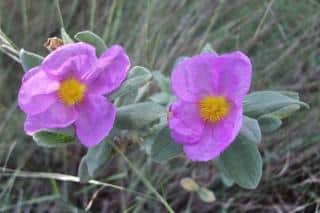

Cistus is a beautiful flower shrub with simply beautiful evergreen leafage.
A summary of Cistus facts
Name – Cistus
Family – Cistaceae
Type – shrub
Height – 3 to 6 ½ feet (1 to 2 meters)
Exposure – full sun
Soil: rather poor – Foliage: evergreen – Flowering: mid to end spring
The pink or white flowers it bears look crumpled and are very ornamental.
Cistus is a typical prairie shrub, very common in Mediterranean areas, and it will adapt well to similar mild, dry climates.
To correctly plant cistus, best plant in spring or fall in a spot that is protected from strong winds.
Propagation of your cistus is either via covered sowing of seeds in spring or cuttings in summer.
Making cuttings is the easiest and fastest method to propagate cistus.
Cistus is an easy shrub to care for, especially when well settled in. Cistus is extremely disease-resistant, no treatment will be necessary.
Pruning cistus
For the bearing to stay bushy or to reduce the size of the shrub, always prune at the end of the blooming season or at the end of winter if that season is cold in your area.
Watering cistus
You’ll only need to water in case of extended dry spell.
As for potted cistus, regular watering is a good idea. Water in summer when the surface of the soil is dry.
Cistus in winter
Protect your shrub with horticultural fleece if you’re planting it in a region where winters are harsh. It’ll hold down to 14°F (-10°C) as long as there isn’t too much moisture in the soil.
If you expect even colder frost spells, your alternative it to grow your cistus in pots and bring it inside away from freezing in winter.
 Cistus bestows us with abundant flowers from the beginning of spring up to summer. Although each single flower lives a short life, they constantly are renewed during the entire blooming season.
Cistus bestows us with abundant flowers from the beginning of spring up to summer. Although each single flower lives a short life, they constantly are renewed during the entire blooming season.
This shrub native to the Mediterranean area generally tops out at about 3 feet (1 meter), but some species can reach 6 ½ feet (2 meters) (Cistus populifolius).
Cistus is used in the worlds of cosmetology and perfume, because it flattens wrinkles. Its essential oil is used for the benefits it shares to skin.
Interesting varieties or cultivars are Cistus monspeliensis, parviflorus, ladaniferus, ‘Silver Pink’ and salvifolius.
Mulch will protect your cistus when winters are cold and hinder weed growth.